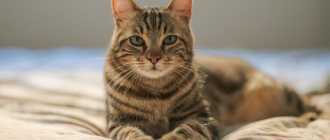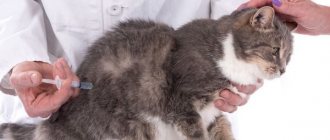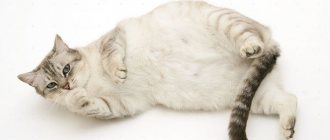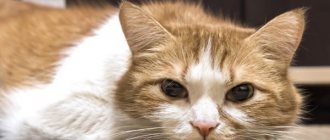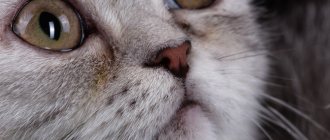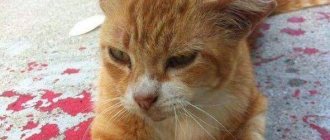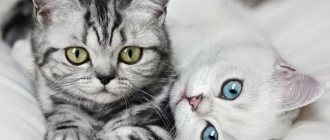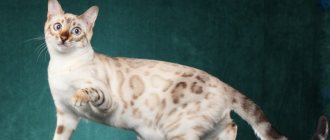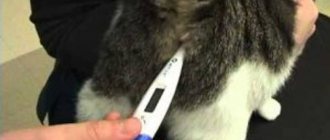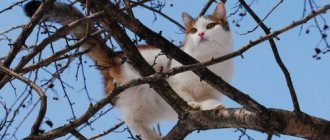Constipation is a problem not only for humans, but also for animals. Cats suffer from defecation retention just like humans. Some owners do not pay attention to the fact that their pet cannot go to the toilet for several days. This is especially difficult to trace if the cat is used to doing its business on the street. In this case, you can look and miss the moment when the animal can be cured with home remedies. Feces that accumulate in the intestines for a long time can provoke various diseases, so it is important to provide timely assistance to your pet.
Causes
Stool retention occurs in animals for many reasons. Sometimes this problem is temporary and depends on the psychological state of the pet. In this case, everything often returns to normal after the cat stops being stressed.
Constipation in cats is divided according to the mechanism of development into:
1) Organic - feces are retained in the intestines due to physical barriers. These are tumors, scars, and other neoplasms.
2) Functional - the cat does not go to the toilet due to deterioration of intestinal motility. The reasons for this are chronic diseases of the gastrointestinal tract, metabolic disorders, sedentary lifestyle, and inappropriate food.
Most often, problems with bowel movements are a symptom of many chronic diseases. Inflammation of the gastrointestinal tract can develop due to poisoning, monotonous diet, parasites, infections, allergies, adhesions, tumors in the intestines, beoar (wool) stones formed from the cat’s own hair, which she licks, kidney pathologies, exposure to medications, pregnancy of the cat, sterilization (castration).
When the cat becomes ill, it becomes aggressive or, on the contrary, lethargic, vomits, and loses its appetite. In severe cases, the animal may develop intestinal obstruction, which dramatically increases the risk of death.
Constipation sometimes signals pancreatitis. In this case, the animal often passes gas, and there is pain in the abdomen (he does not allow the belly to be stroked, the abdomen is tense and bloated). The animal screams in pain.
Problems with bowel movements arise due to low-quality food, which is low in fiber and protein.
Dystrophy is also manifested by constipation. At the same time, the animal loses a lot of weight, has poor hair, and mucous membranes that are bluish in color.
When an animal is infected with parasites, constipation gives way to diarrhea, the stomach becomes large, and the animal itself loses weight, despite the increased appetite.
Problems with stool can provoke poisoning of the animal and inflammation of internal organs, since feces are a source of intoxication.
How to accurately diagnose the disease
Only a veterinarian can identify the exact reason why a cat is bleeding profusely. The animal owner’s task is to help the specialist collect anamnesis. During the consultation you will have to answer the following questions:
- what does a pet eat?
- does he go outside?
- whether there are poisonous plants or other substances hazardous to health in the house that the cat could reach.
The veterinarian will ask how often your pet poops with blood in it and if there are any other warning signs. For example, constipation, diarrhea, poor appetite, depression. During the examination, the cat's temperature is taken.
To establish the exact cause of blood in the stool, additional research will be needed:
- analysis of stool, urine and blood (general, allergen and biochemical);
- Ultrasound of internal organs;
- X-ray of the intestine;
- colonoscopy;
- If tumors are detected, a biopsy will have to be done.
Symptoms of constipation in cats
Constipation is considered a situation when an animal does not have a bowel movement for more than 3 days. Normally, adult cats should go to the toilet most times a day. Kittens digest food faster due to their increased metabolism. Therefore, the norm for them is 1-2 times a day. Elderly pets over 6 years old, whose metabolic processes are reduced, can go once every two days.
Doctors recommend paying attention to the condition of the animal's feces regularly. In a healthy pet, the mass is soft, shiny, dark brown, and oblong in shape. If the consistency of the feces is dry or, on the contrary, liquid, has inclusions, or an unusual color, this is a signal that something is wrong with the animal.
Cats may have complete stool retention, when no stool comes out at all, or partial, when the stool comes out in a minimal amount, most of it remains in the intestines.
This is usually associated with various diseases, so you should pay attention to additional symptoms of constipation. If a pet screams when defecating, does not allow pressure on its stomach or even stroking it strongly, then this may be a symptom of mechanical damage to the pelvic organs, diseases of the internal organs, or gastroenteritis.
If the animal often visits the litter box, but the feces have a liquid consistency, then are replaced by dry ones, or they are not present at all, or they come out in small portions, perhaps we are talking about enterocolitis, gastroenterocolitis.
What might the stool of a sick animal look like?
In the tray of his pet, the owner may find feces that differ in shape:
- ointment-like;
- mushy;
- liquid;
- foamy;
- in the form of “goat peas”;
- in the form of a tape or pencil.
By smell they distinguish: sour, rancid, putrefactive.
- Feces acquire a sour smell when the absorption of fatty acids in the small intestine is disrupted or due to fermentation processes in the large intestine.
- An unpleasant odor, similar to the smell of bad oil, occurs when the secretory function of the pancreas is disrupted or when the flow of bile is disrupted.
- The smell of rotting occurs when digestion in the stomach is disrupted, dyspepsia develops with the proliferation of putrefactive microflora in the intestines. Or the cat suffers from colitis with ulcerations.
It is customary to distinguish feces by color:
- red (beetroot);
- black (tarry);
- dark brown;
- light brown;
- with a scarlet admixture (undigested blood);
- yellow;
- light yellow;
- greenish yellow;
- bleached slightly yellow, gray, gray-white.
A healthy cat can have red or beetroot feces if it has eaten beets or food colored with bright dyes. This coloring is not pathological and soon the stool acquires a normal color.
Helping your pet with constipation
Treating constipation in a cat at home is possible only if it is not caused by a serious illness. Therefore, it is important to have your cat examined by a veterinarian as soon as possible.
If the cause of constipation is known, the issue of establishing bowel movements can be resolved in several ways.
Adjusting the animal's diet
If your cat suffers from constipation periodically, it is necessary to choose food marked i/d. They are designed specifically for animals that have problems with defecation. For example, Hills Prescription Diet Feline wd, Royal Canin Fiber Response, Purina Veterinary Diets OM. They are used in courses or given to the cat on an ongoing basis. Natural fats, high-quality proteins, a large amount of fiber, prebiotics, which are contained in specialized feeds, help to establish intestinal motility and soften stool.
In addition, diet correction occurs as follows:
- Give more liquid. Access to clean water should always be open.
- Fermented milk products or plain milk help well. Sour milk helps improve the functioning of the gastrointestinal tract.
- For constipation, it is better to remove dry food from the diet and introduce wet food instead. It should be given in small portions.
- It is recommended to make homemade food in the form of puree (meat, fish, liver) with a large amount of broth.
- Vegetable feeding is required. You need to add chopped raw beets and carrots to your daily meals. If the animal refuses to eat such food, you can add juice.
- Massage your cat's belly daily in a clockwise direction, applying gentle pressure. It is necessary to adjust the diet.
IMPORTANT! The products that the cat eats should stimulate the intestines, not cause bloating, and be maximally saturated with microelements, water, and vitamins.
Use of oils
Oils (vaseline, castor, vegetable) soften feces and facilitate their easy removal from the body. When choosing vegetable oils, you should pay attention to hemp or olive oils, which are added in small quantities to wet food. They are not recommended to be given frequently, as they put a lot of strain on the liver.
Castor and petrolatum oil for constipation also help relieve the cat from suffering. The procedure is carried out on an empty stomach. 2 ml of oil is poured into the animal’s mouth. The cat should not be fed for the next 2 hours. The intestines empty after 3-5 hours.
IMPORTANT! Vaseline oil does not accumulate in the body, so it is not dangerous for the animal. You should be careful with castor oil. It causes stomach pain in some cats.
Laxatives
If your cat is constipated, laxatives can solve the question of what to do. Veterinarians usually advise using gentle agents administered orally.
These include:
- Lactusan is a prebiotic that copes well with constipation in animals by restoring intestinal microflora and activating intestinal motility.
- Duphalac is a lactulose-based drug that improves intestinal motility.
- Prelax is a lactulose syrup that quickly relieves constipation in animals.
Magnesium sulfate is a medicine in powder form that is diluted in water and poured into the animal’s mouth using a syringe. Begins to act after 6 hours.
ADVICE! A laxative should be given only after consultation with a veterinarian, after examining the cat and determining the causes of constipation. Otherwise, you can only worsen the cat’s condition.
Enema for constipation in cats
Treatment of constipation in cats with an enema is possible only after examination by a veterinarian. In case of chronic diseases and obstruction, it is prohibited to install it!
The enema liquid is a slightly salted solution of water or chamomile infusion, the temperature of which should not exceed 30 degrees. Before the procedure, you need to give Vaseline oil. Take a small syringe, fill it with 180-200 ml of warm solution, and lubricate the tip with Vaseline. Carefully insert the syringe into the cat's anus 1.5 cm and pour in the solution. Take out the syringe and immediately press the tail to the anus. You can gently massage your pet's belly in a clockwise direction. After 10-30 minutes, emptying should occur.
Veterinarians do not recommend giving cats an enema if they have hemorrhoids, cracks in the anus and rectum, the presence of worms, during pregnancy, or if they have heart disease. Otherwise, the procedure will lead to a deterioration in the animal’s condition.
What to do for prevention?
Preventive measures involve systematic treatment for worms. Liquid or dry feces that are constantly observed in a pet are, in any case, evidence of some kind of internal progressive disorder
To prevent consequences dangerous to the cat’s health and life, it is important to follow preventive rules. First of all, it is important to monitor the cat’s diet and provide it with fresh and clean water.
Do not forget to carry out preventive anthelmintic treatment.
If viral infectious diseases develop, do not self-medicate, but take the animal to a veterinarian, who, based on the diagnostic results, will select an effective treatment. In order for the cat’s body to more actively resist various diseases, it is useful to strengthen the pet’s immunity. To do this, it is recommended to give courses of vitamins and various biologically active supplements, which are selected by the veterinarian, taking into account the individual characteristics of the cat.
Diagnostics
Rectal prolapse is a serious problem that, without timely and proper treatment, can lead to the death of the animal. Even if, after partial prolapse, the intestine retracts itself and falls into place, the animal still needs to be shown to a doctor.
Until the cause of the prolapse is eliminated, the animal’s condition will begin to deteriorate. Soon the loss will be complete.
Immediately after the incident, the protruding intestine must be treated with an antiseptic solution to avoid infection. As a last resort, the fallen part can be washed with clean boiled water.
Afterwards, you need to apply a sterile bandage, put the cat in a carrier and immediately go to the veterinary clinic. If the intestine turns blue or black, you cannot wait a minute - the animal needs urgent help.
A visual examination is required to make a diagnosis. Based on the appearance of the intestine, the doctor will make a conclusion about how long ago the prolapse was. It is also important to understand whether the vessels are pinched or whether there are injuries or ruptures in the intestine.
Depending on the stage at which the pathology is, the doctor will prescribe appropriate treatment. In addition, the doctor must determine the cause of rectal prolapse. It is not easy. The animal will have to undergo a series of tests.
- First of all, you will need to have your stool tested to rule out infection with worms.
- A complete blood count may also shed light on the cause.
- Ultrasound examination, X-ray and colonoscopy will help to exclude diseases of internal organs and the appearance of tumors.
Care
The main goal of therapy is to treat the underlying disease, including kidney, liver and lung diseases. Successful treatment should eventually resolve the black stool problem. Fluid therapy will be given to replenish fluid levels in the body, and whole blood transfusions may be required in some patients with severe blood loss and anemia. Patients who experience persistent vomiting will require medications to control the vomiting and allow them to hold onto food long enough to digest it. Severe ulcers or tumors in the gastrointestinal tract may require surgery.
Medicines
Some medications, including hormones and pain relievers, can cause foul-smelling stool. Some vitamin and mineral supplements may also cause an unpleasant odor.
- Solution : Talk to your veterinarian to rule out the possibility that medications are causing foul-smelling feces. Most cat foods these days are completely balanced when it comes to vitamins and minerals, so never add supplements to your cat's diet without first checking with your veterinarian.
Signs of rectal prolapse
With rectal prolapse, the intestine completely or partially falls out of the anus. In the initial stage, only the mucous membrane of the rectum can peek out from the outlet.
This happens immediately after bowel movement. The mucous membrane protrudes slightly.
You can visually see redness and swelling in the anal area. The cat behaves restlessly during defecation. Because of the pain, she meows and constantly licks herself.
Most often, in the initial stages of partial prolapse, the intestine retracts itself and returns to its place. Over time, if the cause is not eliminated, muscle tone will decrease and the intestine will no longer retract.
Since cats do not have hemorrhoids, redness and bulge in the area of the outlet indicate rectal prolapse.
With complete prolapse, the entire tubular structure of the intestine comes out. In this case, the intestine is compressed by the anus in the center. The fallen tissues have a bright scarlet color, they are inflamed and swollen.
If blood flow is obstructed, the intestine turns blue. If timely assistance is not provided, tissue necrosis will soon begin. The intestine will turn black and begin to become covered with ulcers. Tissue death can lead to sepsis.
The following degrees of rectal prolapse can be distinguished:
- First degree. Partial loss occurs after defecation. The intestine straightens itself after some time.
- Second degree. Complete prolapse of the intestine after defecation. You have to put it in place by hand.
- Third degree. Even a slight increase in intra-abdominal pressure leads to prolapse.
- Fourth degree. Any sudden movement can cause rectal prolapse.
